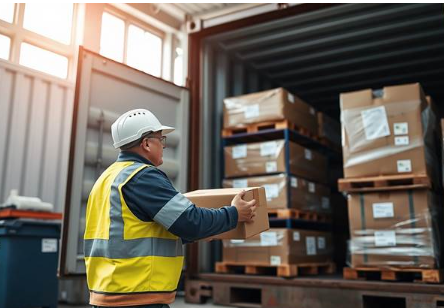Loading a container involves far more than simply stacking items into a limited space. When done correctly, it becomes both a science and an art — one that can significantly influence operational efficiency and overall shipping costs.
In today’s competitive freight and logistics landscape, shipping expenses can take up a large portion of a company’s budget. That’s why learning how to minimize these costs through smart container loading strategies is essential.
This guide will walk you through practical techniques for maximizing container space, including how to use a container loading calculator to optimize layout while ensuring safety and cargo stability. With the right approach, you can reduce the risk of damage during transit, improve handling safety, and make every shipment more cost-effective.
Understanding the Basics of Container Loading
Container loading involves much more than simply filling up available space—it’s a strategic process that can significantly impact shipping efficiency, safety, and cost. Done correctly, it helps optimize freight rates, ensures smoother unloading, and protects cargo throughout transit. It also supports regulatory compliance and preserves container integrity.
However, efficient loading comes with challenges. Among the most critical is:
- weight distribution, imbalance can lead to tipping or shifting during transport,
- tight schedules
- and the diversity of cargo types (fragile, hazardous, temperature-sensitive).
That’s why careful planning is essential. Before loading, inspect the container to confirm it’s clean, dry, and undamaged. A well-thought-out loading plan should account for item size, weight, and type, placing heavier goods at the bottom and lighter items above, ideally using pallets for structure.
Optimizing space has a direct impact on cost-efficiency. Around 21% of transportation and port costs are linked to unused container space, and on some routes, like Australia–China, up to 60% of containers travel empty. Improving load efficiency can boost payload capacity by up to 10%, significantly reducing overall shipping expenses.
Best Practices to Reduce Shipping Costs
Strategic cargo placement inside containers can lead to substantial cost savings in shipping operations. By applying proven loading techniques, businesses can reduce shipping expenses by up to 10% through more efficient space utilization.
1. Focus on Proper Weight Distribution
Proper weight distribution is a cornerstone of cost-effective container loading. Heavier items should be placed at the bottom of the container, with lighter cargo stacked above to maintain stability.
It’s important to avoid concentrating weight in one corner or on one side. Instead, distribute it evenly across the entire container floor. Balanced loading helps prevent cargo shifting during transit, which contributes to approximately $5 billion in global losses each year due to improperly packed containers.
2. Maximize Container Space
Maximizing container space requires careful planning. Stack boxes in an interlocking (brick-like) pattern to evenly distribute pressure. Fill any remaining gaps with suitable dunnage materials such as airbags, foam sheets, or wooden bracing. For partially loaded containers, use horizontal load bars to divide the space into secure compartments.
3. Prevent Cargo Movement
Preventing cargo movement helps reduce damage to both products and containers. Secure items on all sides using lashing points located on the top and bottom side rails and at the corner posts.
Anti-slip mats placed between cargo and the floor can significantly increase friction—raising the coefficient from around 0.6 μ to 0.9 μ—and offer a simple yet effective solution to unwanted movement.
4. Consider a Specialized Container Type
Selecting the appropriate container type is essential for maximizing space, protecting goods during transit, and minimizing shipping costs. Different cargo types require different container designs, depending on factors such as size, weight, shape, sensitivity, or handling needs. Below is an overview of the most common container types and the kinds of cargo they are best suited for:
| Container Type | Best for |
| Standard Shipping Container | General consumer goods such as clothing, electronics, toys, household items, and packaged food products. |
| Open-Top Container | Oversized or irregularly shaped cargo, such as large machinery or equipment, that needs to be loaded from above. |
| Side-Opening Container | Bulky or oversized items that require easier access from the side, facilitating quicker loading/unloading. |
| Flat-Rack Container | Extra-large or heavy items like construction machinery, metal structures, or vehicles that don’t fit in enclosed containers. |
| Reefer (Refrigerated) Container | Temperature-sensitive goods including frozen or fresh food, pharmaceuticals, and chemicals requiring a controlled environment. |
Using Technology to Plan Smarter Loads
Modern technology has fundamentally changed the way businesses manage container loading operations. Today’s advanced load optimization software uses sophisticated algorithms to determine the most efficient cargo arrangements, minimizing wasted space while maintaining proper weight distribution.
Digital planning tools bring significant advantages. For example, load planning software can greatly improve container space utilization, leading to more efficient shipments and increased customer satisfaction. Such systems can process thousands of cargo items within seconds, generating optimal load plans that would take hours to produce manually.
Beyond basic layout optimization, current solutions also include:
- Real-time tracking and monitoring
GPS and sensor technologies provide live updates during the loading process, allowing for proactive adjustments and rapid response to issues. - AI-powered predictive analytics
These systems analyze historical shipping data to forecast demand trends, optimize delivery routes, and identify operational inefficiencies. - Automated container loading systems
Mechanical loading solutions that reduce manual labor, speed up the process, and minimize human error.
Predictive analytics is especially valuable. By leveraging operational data and market trends, these tools help businesses anticipate disruptions and plan accordingly. Their applications include:
- demand forecasting,
- inventory management,
- transportation planning,
- and risk mitigation.
Container tracking systems have also seen major improvements. Modern platforms now provide real-time shipment visibility, with status updates refreshed in under an hour. They successfully track over 99% of key shipping milestones, such as container departure, arrival at port, customs clearance, and final delivery. This level of detail allows businesses to closely monitor high-risk shipments, identify potential delays early, and respond to issues before they escalate.
Additionally,container loading calculators allow companies to determine optimal cargo configurations with greater accuracy. They eliminate guesswork, reduce human error, speed up decision-making, and improve collaboration across teams. By precisely estimating space requirements, these tools help avoid costly mistakes, such as selecting containers that are too small or unnecessarily large.
For businesses aiming to reduce shipping costs, these technologies offer a clear strategic advantage. By enabling smarter planning, maximizing space, and reducing the number of shipments, they deliver both financial and environmental benefits.
READ MORE : Save Space & Watch Offline Your Guide to Downloading HBO Max to an SD Card
Why Smart Loading Pays Off
Efficient container loading is a strategic element of modern logistics, offering significant benefits in cost savings, cargo safety, and operational efficiency. By applying smart loading techniques—such as proper weight distribution, interlocking stacks, and appropriate use of technology like load planning software and tracking tools—businesses can reduce shipping costs, prevent damage, and improve sustainability. When treated as a core part of the supply chain strategy rather than a routine task, container loading becomes a powerful lever for gaining a competitive edge in today’s global market.
Sources:
- https://www.easycargo3d.com/en/try-container-loading-calculator-online-for-free/
- https://www.humano.net/blog/how-to-cut-shipping-costs-with-smart-container-loading-without-sacrificing-safety/
- https://www.freightamigo.com/blog/maximizing-container-efficiency-expert-tips-for-loading-cargo/
- https://www.conquerornetwork.com/blog/2025/05/28/optimizing-container-loads-a-guide-for-freight-forwarders/
- https://incodocs.com/blog/load-planning/
- https://www.freightamigo.com/blog/optimizing-container-stuffing-and-stripping-best-practices-for-efficient-shipping/



